AI Imagery May Destroy History As We Know It
![]()
Artificial intelligence images have the potential to misinform the future. For the first time in the technological present, we are on the cusp of a life-and-art-altering explosion of intentionally created dis-informational imagery.
The Rise of Artificial Intelligence
Prompted art by artificial intelligence (A.I.) is a fact of modern life. Millions of computer-generated images and “art” propagate daily across the internet. A.I. is shared on social media and stored in vast memory banks. A.I. has quickly become part of our digital history but at an enormous emotional and commercial cost to those who still prize the individualism and creativity of image-making.
With its creation in 1987, Photoshop, some argue, delegitimatized photography with this new ability to completely manipulate digital images. Many of these concerns were realized when heavily manipulated images were confused for reality. A.I. takes these concerns to an elevated level which makes even heavy-handed Photoshop look like child’s play.
In 1950 the famous mathematician Alan Turing described the Turing Test, which is a method of inquiry to determine if a computer is capable of sentient thinking. Turing proposed that a computer can possess artificial intelligence if it can mimic human responses. In 1955, Stanford professor John McCarthy is credited with being one of the founding fathers of artificial intelligence. He defined A.I. as “the science and engineering of making intelligent machines”.
Seventy years later, with the recent development of the large language model ChatGPT and image creation programs like Midjourney and DALL-E, the lines between reality and imagination have started to blur…and reality is at stake.
History Unalterably Altered
As a photographer on a 20-year journey to photograph a thousand Native Americans in the present day, I am concerned about the fact that history, itself, will become unalterably altered. Tribal Judge Andew Lester Laverdure from the Turtle Mountain Band of Chippewa recently stated “We are already nearly invisible, we’ve been negatively caricatured, romanticized, and systematically erased. A.I. manipulation and misrepresentation are just a continuation of the erasure. I am saddened by this. I feel a sadness that is hard to describe. I am angry.”
For example, Midjourney is one of today’s most popular A.I. prompted image generators. With just a few simple words of input, the A.I. is capable of generating a myriad of images in just a few seconds. By typing the phrase “Tintype of lost New Mexico tribe circa 1800’s” the problem becomes very evident. The images below were generated in exactly this manner.
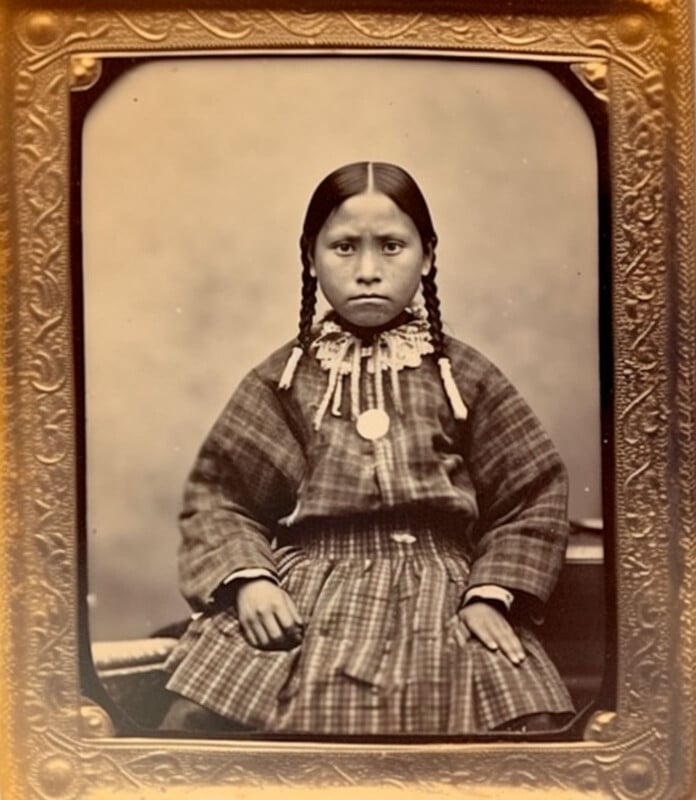
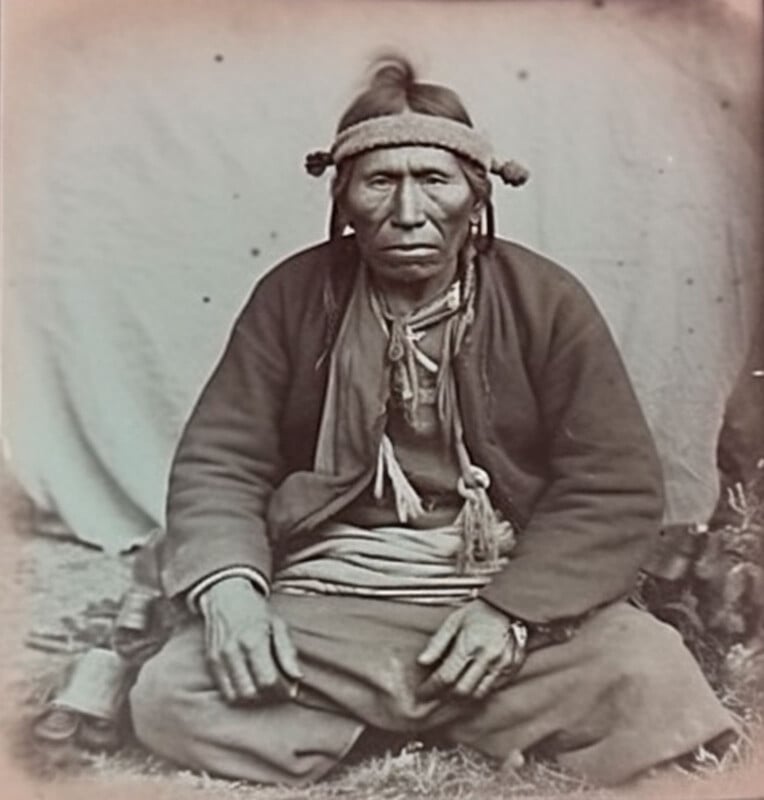
To the random researcher or student, these images look legitimate. But to the trained eye of both historian and portrait photographer, something seems obviously amiss. The hands are often a tell-tale sign of the incompetence of an A.I. program. The software does not comprehend that the human hand should have five digits. The generator is simply finding patterns from previous images and reshuffling them into a new rendition of the keywords with which it was programmed.
The majority of today’s images race through our social media thread. These images are rather convincing as the manner in which they are produced is technologically impressive. The ability to differentiate fiction from reality is further compounded when viewed on the small screen of a smartphone. Few take the time to study the number of digits on the hands of a Native American portrait that was supposedly taken over 100 years ago.
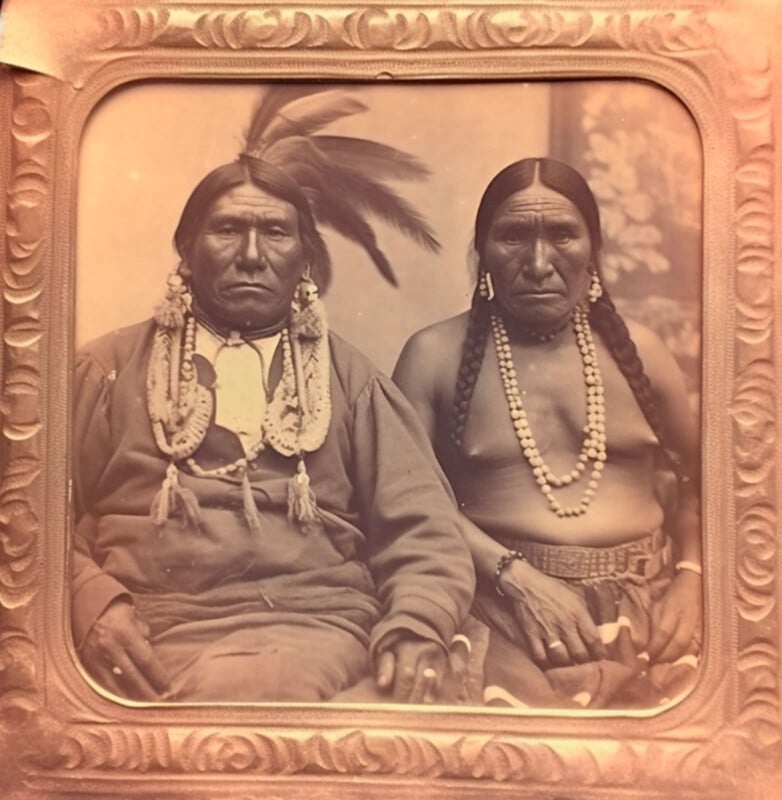
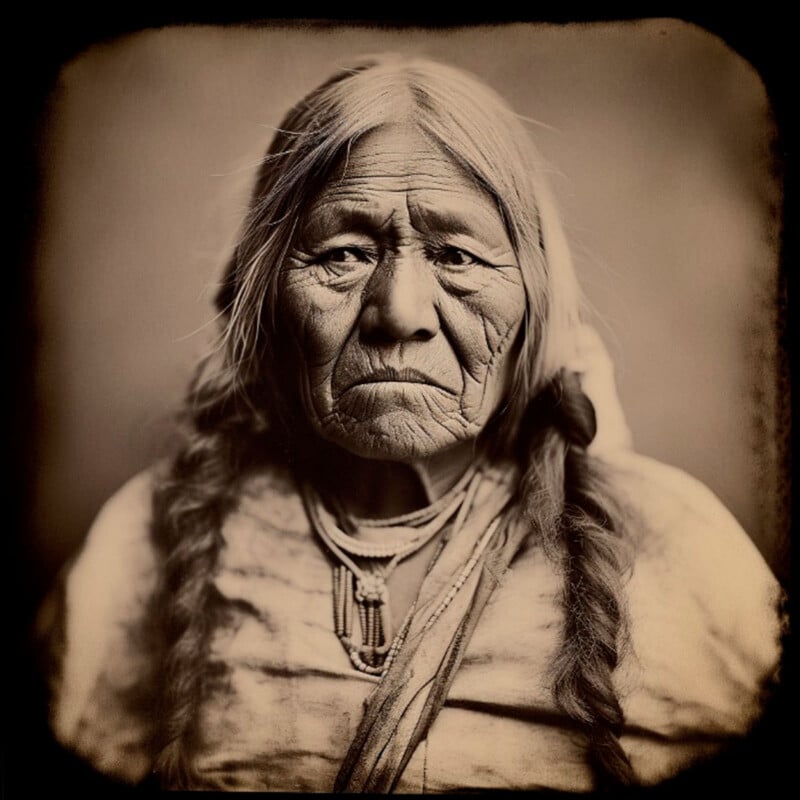
The World is Not Ready
What is both interesting and at the same time terrifying is that these applications improve at an exponential rate. Photographers have watched their progress in a matter of weeks. A year ago, it would be hard to find a convincing A.I. generated portrait image. Today, even the field’s experts are easily duped.
Self-styled ‘photomedia artist’ German Boris Eldagsen recently won the prestigious World Photography Organization’s Sony World Photography Awards, which he entered to make a point: photography needs to be aware of the change that is coming. Respectfully, emphasizing the fact that his entry was an A.I. generated image, he declined the award but the reality is that the future is now. New terminology will evolve to describe these images. Eldagsen coined the term “promptography” because an A.I. image takes a sufficient amount of time to create using several or hundreds of ‘prompts’.
Herein lies the problem: exactly what purpose do these images serve? Analog and digital photography previously presented a window into, and proof of, the distant past. A.I. contrived people do not exist: they have never existed and they will never exist except in the digital ether. The people depicted in these images never lived and they will never die. The human condition of the past is no longer relevant.
Will future generations archive these fake images as historically significant? Will historians mistakenly believe these are depictions of real regalia, dances, and ceremonies performed by authentic tribes? And if so, how does that impact today’s tribes that actively document their real history and heritage? Many experts have already voiced major concerns about “deep fakes” and the troubles they will cause for historians in general.
Eventually, these programs will be training on new imagery as it is made available in real time. At that moment, A.I. will reference previously created A.I. images and incorporate them into its new output. This cannibalistic-type training will result in the further dilution of the truth. At some point in the future, it is conceivable that there could be more fake images on the internet than real photographs…remembering that we produce more digital photographs in one single day than all the analog photographs made in the first 150 years of photography.
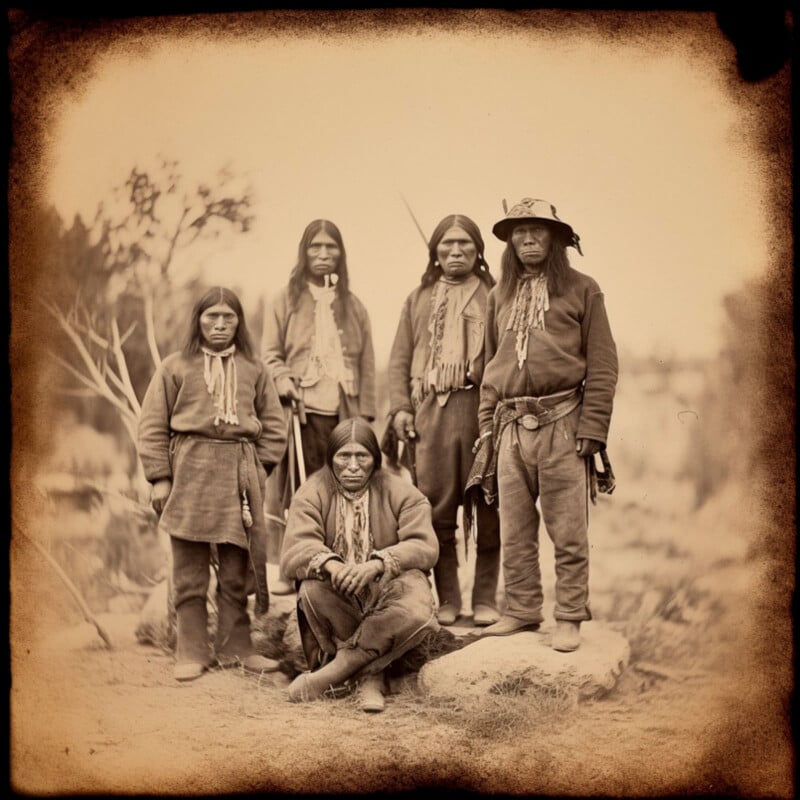
History in the Future
The question then arises: is this the end of recorded history as we know it? “Digital material including key historical documents could be lost forever because programs to view them will become defunct,” said Google Vice-President Vint Cerf back in 2015. Our digital photographs face the technological reality of becoming obsolete, further complicated by A.I. flooding the internet with fake visual documents. In the future who, or even what, will be able to separate legitimate from created history?
Austrian analog photographer Markus Hofstaetter recently proposed that all A.I. images have digital watermarks baked into the digital file. Doing so would make the task of identifying computer-generated images versus real images effortless. This would also create immediate transparency by which we would no longer have to rely on the honesty of A.I. creators. We can also develop A.I. programs that detect the presence of A.I. generated images which would inhibit A.I. created images from invading our news cycle.
Pogo, the eponymous anti-hero of Walt Kelly’s comic strip of the same name, famously declared ‘We have met the enemy, and he is us.’ French painter Paul Delaroche, upon seeing his first daguerreotype in 1840 purportedly exclaimed ‘From today, painting is dead!’
Artists have been, and will always be, surprised and challenged by the advances of technology as it applies to their specific arts, but we continue to evolve as, indeed, everything changes. The chaos wrought upon the creative community by A.I. will eventually subside through assimilation, internalization and eventually control. Now, as ever, what is feared will eventually be embraced as a creative tool – with legitimate boundaries – which will move us another step in the direction of artistic control.
A.I. can be as powerful a tool as it is a legitimate scourge. We have a definite cultural, creative, and contextual problem with this unleashed giant running amok. But as with any advancement, the hardest part of learning is living through the experience, of learning.
“Few will have the greatness to bend history itself; but each of us can work to change a small portion of events, and in the total of all those acts will be written the history of this generation.” —Robert F. Kennedy
The opinions expressed in this article are solely those of the author.
About the authors: Shane Balkowitsch is a wet plate collodion photographer. He has been practicing for over a decade the historic process given to the world by Frederick Scott Archer in 1851. He does not own a digital camera and analog is all that he knows. He has original plates at 64 museums around the globe including the Smithsonian, Library of Congress, The Pitt Rivers Museum at the University of Oxford, and the Royal Photographic Society in the United Kingdom. He is constantly promoting the merits of analog photography to anyone who will listen. His life’s work is “Northern Plains Native Americans: A Modern Wet Plate Perspective” a journey to capture 1,000 Native Americans in the present day in the historic process.
Herbert Ascherman (b. 1947) is Cleveland, Ohio’s, most prominent portrait photographer. Since opening his portrait studio in 1975, Herb has photographed three presidents, more than 200 local artists, 750 Northern Plains Native Americans, and for twenty years, served as the portrait photographer to the Cleveland Orchestra. Herb has produced well over 9,000 black and white film-based portraits in his 47-year career. For the past twenty – three years, Herb has worked with an 8 x 10 Deardorff field view camera, and prints in the resurgent art of hand-made platinum, originally patented in England in 1871. Herb has a library of 2,385 books on photography. He also has a marvelous collection of Daguerreotypes of people and dogs. Throughout his career, Herb has lectured to more than 350 organizations internationally. He has exhibited in more than 150 venues throughout the US, Europe, India, Australia and Japan.